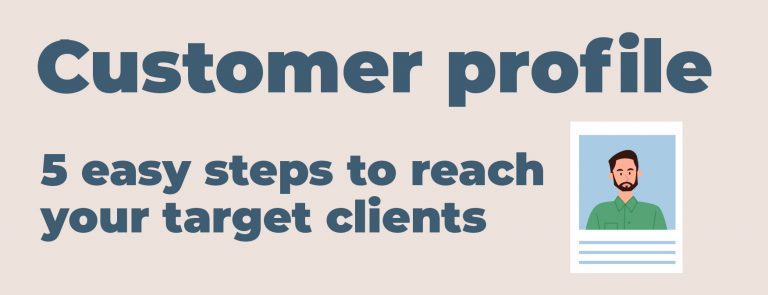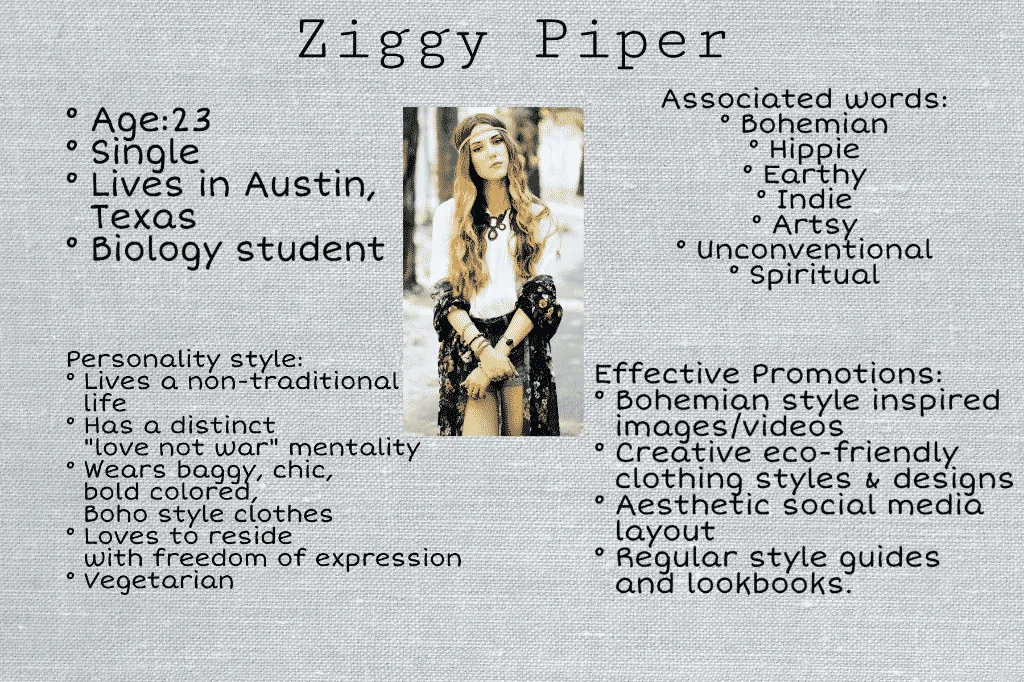Knowledge Base > Marketing Tips > Customer Profile – 5 Easy Steps to Reach Your Target Clients
Customer Profile – 5 Easy Steps to Reach Your Target Clients

Without an accurate customer profile to represent their ideal customers, businesses run the risk of creating campaigns that fail to resonate with their target audience.
As we all know, in today’s competitive market, understanding your customers is more critical than ever, and creating a customer profile is a key step in achieving this understanding.
A customer profile, also known as an ideal customer profile, is a comprehensive description of your ideal customer, created to guide your marketing and sales efforts. Create a customer profile with flipbook creator , so that you and your team can better understand your target audience’s needs and tailor your marketing efforts to meet those needs. Such example of customer profile can be briefly presented or shared in the form below:
Customer profile example
View more customer profile examples
MAKE YOUR OWN
Many businesses can benefit from creating a customer profile, whether designing a persona or using customer profile templates available online. Thanks to this method, you improve customer experience, can understand their needs and pain points better, and use the customer information you obtain to improve the quality of your business.
In this guide, we’ll walk you through the steps of creating a customer profile that will help you identify your ideal customers and target them effectively. We’ll cover everything from gathering data to creating buyer personas, and we’ll provide practical tips to help you get the most out of your customer profile.
By the end of this guide, you’ll have the tools you need to create a comprehensive customer profile that will help you grow your business and achieve your marketing goals. You will also learn how to use Publuu online flipbook maker to change your PDF customer profile templates into great online flipbooks.
What is a customer profile?

A customer profile, also known as an ideal customer profile, is a detailed description of your ideal customer or a previous customer who has purchased your product or service. An ideal customer is a fictional representation of a customer who is the best fit for your products or services. The fit can refer to their demographics (you might sell feminine products to women 16-50) but also other factors like high lifetime value or repeat purchases.
A customer profile contains demographic information like age, gender, income, and location, as well as psychographic information like values, interests, behaviors, and pain points. The goal of creating a customer profile is to gain a thorough understanding of your target audience, allowing you to tailor your sales and marketing efforts to their specific requirements.
A customer profile can be used for both personal and business profiles. Personas are fictional characters that represent your ideal customer by creating a specific character, while business profiles are fictional companies that represent your ideal customer.
In both cases, customer profiles help you to create a clear picture of who your customers are, what they need, and how you can meet those needs.
Why is customer profiling important?
Customer profiling allows you to target your marketing efforts more effectively. By understanding your customer’s needs, wants, and pain points, you can create a message that resonates with them and speaks to their interests, increasing the likelihood of converting them into customers.
Creating a customer profile also helps your sales team understand your customer’s decision-making process at all stages of the customer journey, which helps them to sell more effectively. Knowing what drives your customer to purchase, how they prefer to be approached, and what kind of messaging is most effective, can make the sales process smoother and more efficient.

Furthermore, having a customer profile helps you to better understand your customer’s preferences, which can lead to a better overall experience. By tailoring your products, services, and marketing efforts to their needs, you can create a more personalized experience that resonates with them, leading to higher levels of customer satisfaction and loyalty.
What is the difference between a customer profile and a buyer persona?
While the terms “customer profile” and “buyer persona” are often used interchangeably, there are some differences between these two concepts. A buyer persona also represents an ideal customer, but it’s usually more specific – you can give this fictional customer profile a name, and determine their exact age and occupation.
The key difference between a customer profile and a buyer persona is that a customer profile is based on actual data about existing customers, while a buyer persona is based on assumptions and market research about potential customers. A customer profile is a snapshot of the company’s current customer base, while a buyer persona is a tool for creating marketing strategies that target specific segments of the market.
Imagine that you have a bookstore, and know that a lot of your customers are college students. If you create a customer profile based on this knowledge and what is the subject they study or are interested in, that’s a customer profile. If it’s a hypothetical college student and you are trying to imagine, how would they move around in your bookstore, we’re talking about buyer personas.
B2B vs. B2C customer profiles
B2B customer profiles are typically created for businesses that sell products or services to other businesses. B2B customer profiles may include information about the size and industry of the target business, as well as the job titles, responsibilities, and pain points of the decision-makers within that business. B2B customer profile examples might include “a small freelance graphic designer who needs a file management tool” or “a large international corporation using a CMS tool”.
The focus of a B2B customer profile is often on building relationships with key decision-makers and addressing the specific needs and challenges of the target business. You build customer profiles based on the needs of the businesses and your customer service teams learn how to address any problems related to customer groups.
In contrast, B2C customer profiles are created for businesses that sell products or services directly to individual consumers. B2C customer profiles may include information about the age, gender, income, and interests of the target consumer, as well as their shopping behavior and preferences. The focus of a B2C customer profile is often on creating messaging that resonates with the emotions and desires of the individual consumer and addressing their specific needs and pain points.
Customer profiling in marketing, sales, and support

Customer profiling is an effective tool that will help your business grow. By developing a comprehensive customer profile, companies can better understand the desires, needs, and preferences of their customers, allowing them to tailor marketing efforts to specific audiences. Customer targeting is the foundation of effective marketing.
When it comes to sales, customer profiling allows you to identify and target high-value potential customers. When you have profiles, you can create sales proposals that target just that customer. Well-developed preferences and behaviors lead to higher customer satisfaction and loyalty.
How to create a customer profile
1. Identify your best customers
To find out which customers are worth profiling, study your current customer base to determine which customers are most profitable or loyal. Study their buying habits, for example, how often they buy from you, how much they spend, and how long they have been customers. From this, you will just determine the customer profile.
2. List their notable attributes
Once you’ve identified your best customers, make a list of their characteristics, such as age, gender, income, education, position, and, in the case of companies, industry, company size, and location. You can determine many of these from profiles or personas. You can profile men between 20 and 30 years of age, or one-man or small advertising agencies with an online presence. This data will help you create a profile of your ideal customer.
3. Survey them
Once you have a vague idea of your target customers, it’s time to start to gather customer data – you can start a survey using one of several services online, like Google Docs. You can also use Publuu flipbooks’ web analytics, which allows you to link to a survey, combined with our robust analytics feature to gather data points.
In the survey, you can gather customer data, from basic demographic data to more personal-level questions. Use these valuable insights to fill in the customer profile template and create the main consumer profile for each notable demographic.
Below you can find the most common types of consumer profiling questions asked when in comes to surveying your customers:
In this section of the survey, your customers can describe age, sex, gender, marital status, education, and occupation.
In these sections of a customer profile template, customers describe their work-related factors, such as their income, employment status, their industry or sector, size of the company, or decisiveness power (job title or position).
These questions tend to describe the personality of the customer profile section: hobbies, interests, beliefs, motivations, and goals. You can outright ask what this person does in their spare time or prompt them to pick sentences they agree with.
Some of these questions can be replaced by geolocation: ask the customer about their country, region, or state, whether they live in a large town or a village, and so on.
These questions are used to fill in the customer profile for companies: the industry, company size, annual revenue, size of the sales team, or marketing team. Sometimes you don’t have to estimate the entire company – just a certain division of branch helps you in lead generation.
4. Extract data from your online channels

Now you have several important data points. Take the gathered survey data together, as well as analyze data from your website, Publuu flipbooks, social media channels, and other online platforms to learn more about your customers. These data can help you understand their wants, needs, and preferences.
The customer profile template should include information such as demographics, psychographics, behavior patterns, crucial problems, and buying habits. Having a customer profile template will help you keep track of your customers’ information and make informed decisions about your marketing strategy.
5. Fill in your customer profile template
Pick a customer profile template to organize the data you have collected and create a comprehensive profile of your ideal customer. There are many customer profile templates available online on sites like Canva, which will help you design attractive customer profiles that look great. Use a tool like Canva or InDesign to fill in the details, and convert the final PDF as an online flipbook using Publuu flipbook maker for everyone to see.
You can easily share your customer profile in a form of flipbook, add crucial information about your customers and add helpful sources as a link, photo gallery or video hotspot. Any of the recipients of such flipbook can also add their private notes for their notices and suggestions.
Worried that not all of the recipients opened the customer profile? Add tracking links to your flipbook to find out who has opened the document and how much time they have spent studying it. You will get notified if somoone has not opened it.
The benefits of customer profiles
If you create a customer profile you will be able to shape your company and marketing team to target the ideal customer and improve your sales.
Targeted content
Your sales and marketing campaigns can be produced by targeted content that addresses the needs and preferences of important customer segments. Thanks to the customer profile you have created, you can create content using the best content marketing tools out there, and match their profile. With that, you will be able to generate engagement and drive further sales.
Enhance your customer service
Knowing what your customers need makes your sales team members more effective. Creating customer profiles helps you understand needs, preferences, and behaviors and you can match your support and services to better meet their needs.
Build customer loyalty
When you create customer profiles, you can identify the attributes and behaviors of your ideal customers who are more likely to remain loyal to your brand over time. Armed with this knowledge, you can create targeted retention campaigns that aim to deepen customer engagement and increase loyalty.
Reduce churn
Customer profiles can help you detect current customers that are close to abandoning your brand. If you recognize their pain points, you can detect their needs, and run marketing campaigns that increase customer retention and further build strong brand loyalty .
Boost sales
Finally, using customer profiles can also help you boost sales. By identifying your ideal customers, you can create more effective marketing campaigns that are tailored to their specific needs and behaviors.
Customer profile examples

This customer profile example can be used to pinpoint profiles of specific groups of people. It divides them into groups and helps you determine behaviors and goals of multiple customer profiles.

This is an example of a buyer persona . You can format your customer profile however you like – creating a simple customer profile template might require just a couple of key phrases. With personas, images help you visualize the ideal customer browsing your store.

This customer profile template is great example for both business customers and individual ones, and it will help you segment the marketing needs of your company. Additionally it comes down to 6 segments that can be crucial in determing your ideal customer.
Summary
Creating and maintaining a customer profile is an ongoing process that requires constant updates and revisions to ensure that you stay ahead of changes in your market and your customers’ needs.
With a well-defined customer profile, your teams can make informed decisions that align with your business goals and help you achieve long-term success. Publish it online with Publuu so that all your workers and marketing teams can have easy access to your ideal customer profile.
You may be also interested in:
How to Generate Leads?
12 Tips to Create a Powerful Lead Magnet
Convert your PDF to flipbook today!
Go beyond boring PDF and create digital flipbook for free.
Register with Publuu for free today and check out all the smart options we prepared for you!















